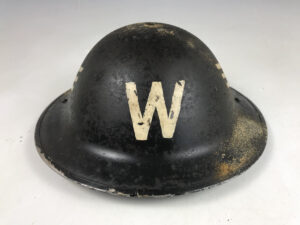Forgotten Friday – A.R.P Warden
In today’s #ForgottenFriday we are looking into the role of an A.R.P Warden in the Second World War and how vital they were for war effort on the Home Front!
But what was an ARP Warden and what was their role?
Thousands of men and women volunteered to be Air Raid Precautions (ARP) Wardens during the Second World War. An ARP Warden patrolled the streets and told people to put their lights out to maintain the Blackout. All lights needed to be turned as it may have attracted attention or guided German aircraft to ground targets. Most ARPs carried a gas mask. They handed these out with leaflets about what to do in the event of an air raid. Every man, woman and child were issued with a gas mask to protect themselves against poisonous gas bombs. When news of an enemy air raid was communicated by the Royal Observer Corps, ARP Wardens sounded sirens and whistles to alert civilians to take cover in air-raid shelters to protect them from the falling bombs. In the aftermath of a bombing raid ARP Wardens helped to put out fires caused by incendiary bombs and provided first-aid to any injured civilians.[1]

Two A.R.P Wardens in communication.
What did they wear?
At the beginning of the war, ARP wardens had no uniform, but wore their own clothes (wardens wore helmets, arm bands and badges on their civilian clothes) and in October 1939 issued with overalls with a red on black ‘ARP’ badge. From the formation of the ARP until 1939, the badges were produced by the Royal Mint and made of solid sterling silver, with a crescent-shaped buttonhole attachment for men and a pin style brooch for women. From 1940 on, the badges were made of a base metal. From May 1941 full-time and regular part-time wardens were issued with dark blue battledress and beret. Women were issued with a four-pocket tunic, again in dark blue serge with skirt. ARP service personnel were issued with Mk. II British helmets. These were often not made to the same level as issued to soldiers to reduce costs. These helmets, which had less resistance to ballistic impact, would have small holes drilled in the rim to show they were not for front line use. Depending on the role of the person the helmet would be marked with a letter or letters to easily allow others to ascertain their role at an incident.

A.R.P Warden next to Warden Post.
Here are some of the meanings which were painted onto the helmets of the A.R.P:
W for wardens (some warden/fire guards had W/FG). Rank within the warden service was denoted by a white helmet and black bands.
R for rescue services (later HR and LR were used for heavy and light rescue parties)
FAP for first aid parties
SP for stretcher parties (to carry injured from incidents)
A for ambulance drivers
M for messenger/runner

A.R.P Warden’s Helmet
What was the A.R.P Wardens role in the Blitz?
The role of ARP services came into their own during the Blitz of 1940–41. ARP control centres would sound the air raid sirens and wardens would marshal people into the shelters and then watch out for the fall of any bombs within their sector – often done during air raids and therefore highly dangerous.[2]
When the wardens came across the site of a bombing they would telephone for the emergency services, render first aid to victims with minor injuries and deal with small fires (placing sand on incendiary devices). Other ARP units included first-aid, light and heavy rescue parties, stretcher parties and messenger boys and girls (who cycled between incidents carrying messages from wardens). Other duties included helping to police areas suffering bomb damage and helping bombed-out householders. They were also tasked with keeping an emergency under control until official rescue services arrived.
From 1 September 1939 a small percentage of ARP wardens were full-time and were paid a salary (£3 for men, £2 for women), but most were part-time volunteers who carried out their ARP duties as well as full-time jobs. Part-time wardens were supposed to be on duty about three nights a week, but this increased greatly when the bombing was heaviest. One in six was a woman, and amongst the men there were a significant number of veterans of World War I who wanted to help with the war effort.

A.R.P Warden and Messenger
Bibliography:
Haldane, J. B.. A.R.P – Air Raid Precautions. United Kingdom: Read Books Limited, 2013.
Brown, Mike. Put that Light Out! Britain’s Civil Defence Service at War 1939-1945. United Kingdom: Sutton, 1999.
[1] Brown, Mike. Put that Light Out! Britain’s Civil Defence Service at War 1939-1945. United Kingdom: Sutton, 1999.
[2] Haldane, J. B.. A.R.P – Air Raid Precautions. United Kingdom: Read Books Limited, 2013.

